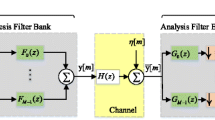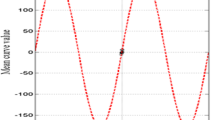Abstract
In this paper, a joint covariance power fitting and phase based blind estimation method for carrier frequency offset (CFO) is proposed for orthogonal frequency division multiplexing (OFDM) systems using constant modulus constellations. Based on the assumption that the channel varies slowly within two adjacent OFDM symbols, the influence of the channel on corresponding covariance values and phase of the two OFDM symbols will be the same. Utilizing this, a robust method is formulated based on covariance power fitting criterion and phase information between two nearby OFDM symbols. The mean square error and bit-error-rate performance of the proposed estimation method is compared with that of the prominent conventional estimation schemes under noisy multipath channels with high delay spreads and Doppler spreads. Based on Monte Carlo simulations, it is shown that the proposed method is robust under different channel conditions and provides more accurate CFO estimates.











Similar content being viewed by others
References
van Nee, R., & Prasad, R. (2000). OFDM for wireless multimedia communications. Norwood, MA: Artech House, Inc.
ETSI Normalization Committee et al. (1995). Radio broadcasting systems, digital audio broadcasting (DAB) to mobile, portable and fixed receivers (Vol. 300, No. 401). Norme ETSI, Sophia-Antipolis, France, Doc. ETS, pp. 1995–1997.
Reimers, U. (1998). Digital video broadcasting. IEEE Communications Magazine, 36(6), 104–110.
Li, Y. G., & Stuber, G. L. (2006). Orthogonal frequency division multiplexing for wireless communications. Berlin: Springer.
Fazal, K., & Kaiser, S. (2008). Multi-carrier and spread spectrum systems: From OFDM and MC-CDMA to LT. New York: Wiley.
Yao, Y., & Giannakis, G. B. (2005). Blind carrier frequency offset estimation in SISO, MIMO, and multiuser OFDM systems. IEEE Transactions on Communications, 53(1), 173–183.
Al-Dweik, A. J. (2004). Robust non data-aided frequency offset estimation technique. In 15th IEEE international symposium on personal, indoor and mobile radio communications, 2004. PIMRC 2004 (Vol. 2), pp. 1365–1369
Zeng, X. N., & Ghrayeb, A. (2008). A blind carrier frequency offset estimation scheme for OFDM systems with constant modulus signaling. IEEE Transactions on Communications, 56(7), 1032–1037.
Al-Dweik, A., Hazmi, A., Younis, S., Sharif, B., & Tsimenidis, C. (2010). Carrier frequency offset estimation for OFDM systems over mobile radio channels. IEEE Transactions on Vehicular Technology, 59(2), 974–979.
Lmai, S., Bourre, A., Laot, C., & Houcke, S. (2014). An efficient blind estimation of carrier frequency offset in OFDM systems. IEEE Transactions on Vehicular Technology, 63(4), 1945–1950.
Oh, J.-H., Kim, J.-G., & Lim, J.-T. (2011). Blind carrier frequency offset estimation for OFDM systems with constant modulus constellations. IEEE Communications Letters, 15(9), 971–973.
Al-Dweik, A., Hazmi, A., Younis, S., Sharif, B., & Tsimenidis, C. (2010). Blind iterative frequency offset estimator for orthogonal frequency division multiplexing systems. IET Communications, 4(16), 2008–2019.
Roman, T., Visuri, S., & Koivunen, V. (2006). Blind frequency synchronization in OFDM via diagonality criterion. IEEE Transactions on Signal Processing, 54(8), 3125–3135.
Author information
Authors and Affiliations
Corresponding author
Appendix
Appendix
The derivation of the cost function given by (13) is presented in this Appendix. Let the first column of the covariance matrix \({\mathbf{R }}_n\left( \overline{\varepsilon }\right) \) be \({\mathbf r} _m\left( l\right) =\left[ r_m(0),r_m(1),\ldots ,r_m(N-1)\right] ^T\). \({\mathbf{R }}_m\left( \overline{\varepsilon }\right) \)is obtained using the matrix \({\mathbf{D }}_m\left( \overline{\varepsilon }\right)\). From (6) and (8), the l-th element of the \({\mathbf{r }}_m\left( l\right)\) vector is obtained as
The relationship between \(\widehat{\mathbf{d }}_m\) and \({\mathbf{d }}_m\) is obtained from (2), (3) and (6) as
If \({\mathbf{d }}_m=\left[ d_m(0),d_m(1),\ldots ,d_m(N-1)\right] ^T\), the \(a^{th}\) element of the vector \({\widehat{\mathbf{d }}}_m\) is given by
Let \(\sum ^{N-l-1}_{p=0}{d_m\left( p+l\right) {d^*}_m\left( p\right) }\) be \({\lambda }_{m,l}\) and \(\sum ^{N-1}_{p=N-l}{d_m\left( p+l-N\right) {d^*}_m\left( p\right) }\) be \({\mu }_{m,l}\). Then
Similarly,
and
Let \(\left( {\lambda }_{m+1,l}-{\lambda }_{m,l}\right)\)=\({\lambda }_l\) and \(\left( {\mu }_{m+1,l}-{\mu }_{m,l}\right)\)=\({\mu }_l\). Then \({\left\| r_{m+1}\left( l\right) -r_m\left( l\right) \right\| }^2\) can be minimized to
Since the channel characteristics remains invariant between two adjacent OFDM symbols, in the absence of CFO and at high SNR, \(r_{m+1}\left( l\right) =r_m\left( l\right)\). Hence, \(\left( \lambda _{m+1,l}+\mu _{m+1,l}\right) =\left( \lambda _{m,l}+\mu _{m,l}\right)\). Therefore, \(\left( \lambda _{m+1,l}-\lambda _{m,l}\right) =-\left( \mu _{m+1,l}-\mu _{m,l}\right)\). i.e. \(\lambda _{l}=-\mu _{l}\). Hence the term \({\text {Im}}\left\{ \lambda ^*_{l}\mu _{l}\right\}\), associated with the sinusoidal term in (24) becomes \(-{\text {Im}}\left\{ \left| \lambda _{l}\right| ^2\right\}\) which is zero. Substituting \(\lambda _{l}=-\mu _{l}\) in (24), \({\left\| r_{m+1}\left( l\right) -r_m\left( l\right) \right\| }^2=2{\left| \lambda _{l} \right| ^2}-2{\left| \lambda _{l} \right| ^2}\cos {2\pi \left( \varepsilon -\overline{\varepsilon }\right) }\). If, \(-2{\left| \lambda _{l} \right| ^2}=A\), \({\left\| r_{m+1}\left( l\right) -r_m\left( l\right) \right\| }^2=A{\cos 2\pi \left( \varepsilon -\overline{\varepsilon }\right) \ }-A\). The constant in the equation is independent of \(\left( \varepsilon -\overline{\varepsilon }\right)\) and the cost function of (11) can be approximated as \(J\left( \overline{\varepsilon }\right) =A\cos \left( 2\pi \left( \varepsilon -\overline{\varepsilon }\right) \right) -A\).
Rights and permissions
About this article
Cite this article
Jayaprakash, A., Reddy, G.R. Robust Blind Carrier Frequency Offset Estimation Algorithm for OFDM Systems. Wireless Pers Commun 94, 777–791 (2017). https://doi.org/10.1007/s11277-016-3650-9
Published:
Issue Date:
DOI: https://doi.org/10.1007/s11277-016-3650-9




